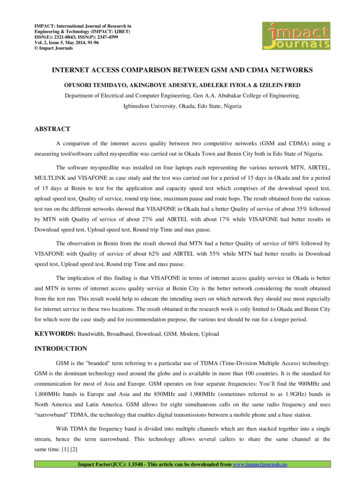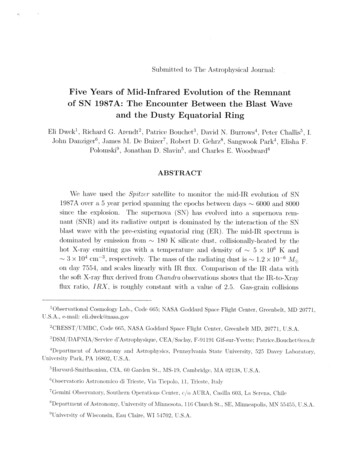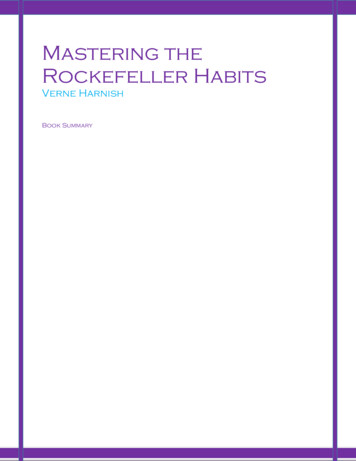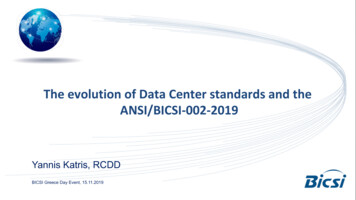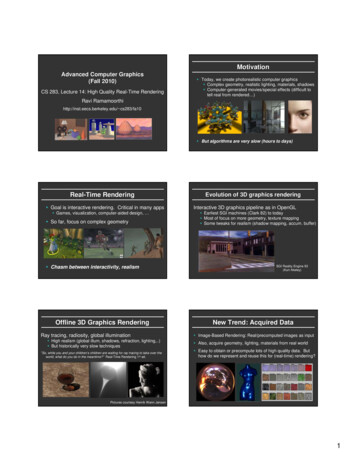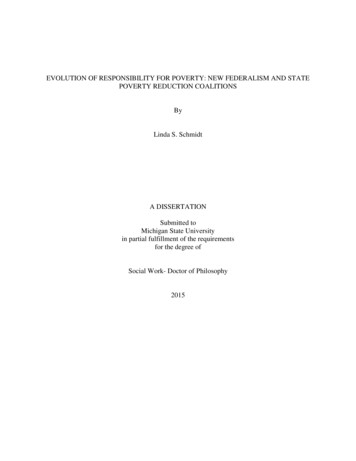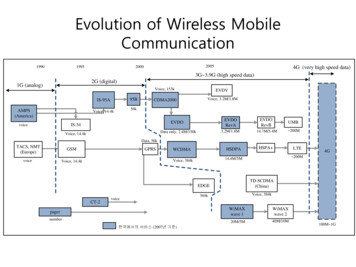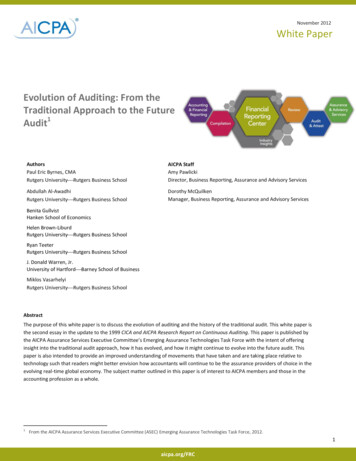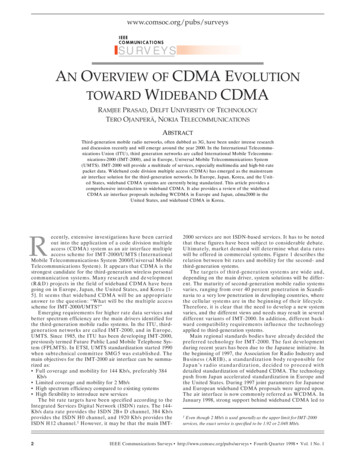
Transcription
YSAN OVERVIEW OF CDMA EVOLUTIONTOWARD WIDEBAND CDMARAMJEE PRASAD, DELFT UNIVERSITY OF TECHNOLOGYTERO OJANPERÄ, NOKIA TELECOMMUNICATIONSABSTRACTThird-generation mobile radio networks, often dubbed as 3G, have been under intense researchand discussion recently and will emerge around the year 2000. In the International Telecommunications Union (ITU), third generation networks are called International Mobile Telecommunications-2000 (IMT-2000), and in Europe, Universal Mobile Telecommunications System(UMTS). IMT-2000 will provide a multitude of services, especially multimedia and high-bit-ratepacket data. Wideband code division multiple access (CDMA) has emerged as the mainstreamair interface solution for the third-generation networks. In Europe, Japan, Korea, and the United States, wideband CDMA systems are currently being standarized. This article provides acomprehensive introduction to wideband CDMA. It also provides a review of the widebandCDMA air interface proposals including WCDMA in Europe and Japan, cdma2000 in theUnited States, and wideband CDMA in Korea.ecently, extensive investigations have been carriedout into the application of a code division multipleaccess (CDMA) system as an air interface multipleaccess scheme for IMT-2000/UMTS (InternationalMobile Telecommunications System 2000/Universal MobileTelecommunications System). It appears that CDMA is thestrongest candidate for the third-generation wireless personalcommunication systems. Many research and development(R&D) projects in the field of wideband CDMA have beengoing on in Europe, Japan, the United States, and Korea [15]. It seems that wideband CDMA will be an appropriateanswer to the question: “What will be the multiple accessscheme for IMT-2000/UMTS?”Emerging requirements for higher rate data services andbetter spectrum efficiency are the main drivers identified forthe third-generation mobile radio systems. In the ITU, thirdgeneration networks are called IMT-2000, and in Europe,UMTS. Since 1985, the ITU has been developing IMT-2000,previously termed Future Public Land Mobile Telephone System (FPLMTS). In ETSI, UMTS standardization started 1990when subtechnical committee SMG5 was established. Themain objectives for the IMT-2000 air interface can be summarized as: Full coverage and mobility for 144 Kb/s, preferably 384Kb/s Limited coverage and mobility for 2 Mb/s High spectrum efficiency compared to existing systems High flexibility to introduce new servicesThe bit rate targets have been specified according to theIntegrated Services Digital Network (ISDN) rates. The 144Kb/s data rate provides the ISDN 2B D channel, 384 Kb/sprovides the ISDN H0 channel, and 1920 Kb/s provides theISDN H12 channel.1 However, it may be that the main IMT-R22000 services are not ISDN-based services. It has to be notedthat these figures have been subject to considerable debate.Ultimately, market demand will determine what data rateswill be offered in commercial systems. Figure 1 describes therelation between bit rates and mobility for the second- andthird-generation systems.The targets of third-generation systems are wide and,depending on the main driver, system solutions will be different. The maturity of second-generation mobile radio systemsvaries, ranging from over 40 percent penetration in Scandinavia to a very low penetration in developing countries, wherethe cellular systems are in the beginning of their lifecycle.Therefore, it is clear that the need to develop a new systemvaries, and the different views and needs may result in severaldifferent variants of IMT-2000. In addition, different backward compatibility requirements influence the technologyapplied to third-generation systems.Main regional standards bodies have already decided thepreferred technology for IMT-2000. The fast developmentduring recent years has been due to the Japanese initiative. Inthe beginning of 1997, the Association for Radio Industry andBusiness (ARIB), a standardization body responsible forJapan’s radio standardization, decided to proceed withdetailed standardization of wideband CDMA. The technologypush from Japan accelerated standardization in Europe andthe United States. During 1997 joint parameters for Japaneseand European wideband CDMA proposals were agreed upon.The air interface is now commonly referred as WCDMA. InJanuary 1998, strong support behind wideband CDMA led to1Even though 2 Mb/s is used generally as the upper limit for IMT-2000services, the exact service is specified to be 1.92 or 2.048 Mb/s.IEEE Communications Surveys http://www.comsoc.org/pubs/surveys Fourth Quarter 1998 Vol. 1 No. 1
User bit rate2 Mb/sthe selection of WCDMA as the UMTS terrestrialair interface scheme for FDD frequency bands inETSI. The selection of wideband CDMA was alsoIMT-2000backed by Asian and American GSM operators. ForTDD bands, a time division CDMA (TD-CDMA)384 Kb/sconcept was selected. In the United States in March1998, the TIA (Telecommunications Industry AssoGSM edgeciation) TR45.5 committee, responsible for IS-95standardization, adopted a framework for wideband144 Kb/sCDMA backward compatible to IS-95, calledEvolved second generation (GSM HSCSD and GPRS, IS-95B)cdma2000. TR45.3, responsible for IS-136 standard10 Kb/sization, adopted a TDMA-based third-generationBasic second generation (GSM,IS-95, IS-136, PDC)proposal, UWC-136 (Universal Wireless Communications), based on the recommendation from theFixed / low mobilityWide area / high mobilityUWCC in February 1998. Korea is still consideringtwo wideband CDMA technologies, one similar to Figure 1. IMT-2000 user bit rate vs. coverage and mobility.WCDMA and the other similar to cdma2000.The preferred technology for third-generationsystems depends on technical, political, and business factors.starting from the 1950s after the invention of the ShannonTechnical factors include issues such as provision of requiredtheorem [6]. An extensive overview of spread spectrum historydata rates, and performance. Political factors involve reachingis given in [7].agreement between standards bodies and taking into accountIn 1949, John Pierce wrote a technical memorandumthe different starting points of different countries and regions.where he described a multiplexing system in which a commonOn one hand, the investments into the existing systems motimedium carries coded signals that need not be synchronized.vate a backward compatibility approach. On the other, newThis system can be classified as a time hopping spread specbusiness opportunities or the possibility of changing the curtrum multiple access system [7]. Claude Shannon and Robertrent situation might motivate a new approach.Pierce introduced the basic ideas of CDMA in 1949 byThis article is organized as follows. The past, present, anddescribing the interference averaging effect and the gracefulfuture activities of CDMA are presented in the next section.degradation of CDMA [8]. In 1950, De Rosa-Rogoff proThe following section explains the basic concepts and eleposed a direct sequence spread spectrum system and introments of CDMA. Then the IS-95 air interface is introducedduced the processing gain equation and noise multiplexingaccording to the new IS-95 standard, followed by a brief disidea [7]. In 1956, Price and Green filed for the antimultipathcussion of air interface technologies for third-generation, with“RAKE” patent [7]. Signals arriving over different propagaa short description of TD-CDMA. Wideband CDMA schemestion paths can be resolved by a wideband spread spectrum sigare then discussed in great length and conclusions are given innal and combined by the RAKE receiver. The near-farthe final section.problem (i.e., a high interference overwhelming a weakerspread spectrum signal) was first mentioned in 1961 by Magnuski [7].For cellular application spread spectrum was suggested byCDMA: PAST, PRESENT, AND FUTURECooper and Nettleton in 1978 [9]. During the 1980s Qualcomm investigated DS-CDMA techniques, which finally led toThe origins of spread spectrum are in military field andthe commercialization of cellular spread spectrum communinavigation systems. Techniques developed to counteract intencations in the form of the narrowband CDMA IS-95 standardtional jamming have also proved suitable for communicationin July 1993. Commercial operation of IS-95 systems startedthrough dispersive channels in cellular applications. In thisin 1996. Multiuser detection (MUD) has been subject tosection we highlight the milestones for CDMA developmentextensive research since 1986 when Verdu formulated an optimum multiuser detection for thePioneer Eraadditive white Gaussian noise (AWGN) channel,1949 John Pierce: time hopping spread spectrummaximum likelihood sequence estimator (MLSE)1949 Claude Shannon and Robert Pierce: basic ideas of CDMA[10].1950 De Rosa-Rogoff: direct sequence spread spectrumDuring the 1990s wideband CDMA tech1956 Price and Green: antimultipath “RAKE” patentniques with a bandwidth of 5 MHz or more have1961 Magnuski: near-far problembeen studied intensively throughout the world,1970s Several developments for military field and navigation systemsand several trial systems have been built andNarrowband CDMA Eratested [4]. These include FRAMES Multiple1978 Cooper and Nettleton: cellular application of spread spectrumAccess (FRAMES FMA2) in Europe, Core-A in1980s Investigation of narrowband CDMA techniques for cellular applicationsJapan, the European/Japanese harmonized1986 Formulation of optimum multiuser detection by VerduWCDMA scheme, cdma2000 in the United1993 IS-95 standardStates, and the Telecommunication TechnologyAssociation I and II (TTA I and TTA II)Wideband CDMA Eraschemes in Korea. Introduction of third-genera1995 Europe:FRAMES FMA2tion wireless communication systems using wideJapan:Core-AWCDMAband CDMA is expected around the year 2000.USA:cdma2000Based on the above description, the CDMAKorea:TTA I TTA IIera is divided in three periods: the pioneer2000s Commercialization of wideband CDMA systemsCDMA era, the narrowband CDMA era, and Table 1. CDMA era.the wideband CDMA era, as shown in Table 1.IEEE Communications Surveys http://www.comsoc.org/pubs/surveys Fourth Quarter 1998 Vol. 1 No. 13
CDMA CONCEPTSIn CDMA each user is assigned a unique code sequence ituses to encode its information-bearing signal. The receiver,knowing the code sequences of the user, decodes a receivedsignal after reception and recovers the original data. This ispossible since the crosscorrelations between the code of thedesired user and the codes of the other users are small. Sincethe bandwidth of the code signal is chosen to be much largerthan the bandwidth of the information-bearing signal, theencoding process enlarges (spreads) the spectrum of the signal and is therefore also known as spread-spectrum modulation. The resulting signal is also called a spread-spectrumsignal, and CDMA is often denoted as spread-spectrum multiple access (SSMA) [1–3, 11–12].The spectral spreading of the transmitted signal gives toCDMA its multiple access capability. It is therefore importantto know the techniques necessary to generate spread-spectrumsignals and the properties of these signals. A spread-spectrummodulation technique must be fulfill two criteria: The transmission bandwidth must be much larger thanthe information bandwidth. The resulting radio-frequency bandwidth is determinedby a function other than the information being sent (sothe bandwidth is statistically independent of the information signal). This excludes modulation techniques likefrequency modulation (FM) and phase modulation (PM).The ratio of transmitted bandwidth to information bandwidth is called the processing gain, Gp, of the spread-spectrumsystem,BGp t(1)Biwhere B t is the transmission bandwidth and B i is the bandwidth of the information-bearing signal.The receiver correlates the received signal with a synchronously generated replica of the spreading code to recoverthe original information-bearing signal. This implies that thereceiver must know the code used to modulate the data.Because of the coding and the resulting enlarged bandwidth, SS signals have a number of properties that differ fromthe properties of narrowband signals. The most interestingones, from the communication systems point of view, are discussed below. To have a clear understanding, each propertyhas been briefly explained with the help of illustrations, if necessary, by applying direct sequence spread-spectrum techniques.11&212122(a)(b) Figure 2. Principle of spread-spectrum multiple access.issi Figure 3. Interference rejection.provided each user has a unique code that has a sufficiently low cross-correlation with the other codes. Correlatingthe received signal with a code signal from a certain userwill then only despread the signal of this user, while theother spread-spectrum signals will remain spread over alarge bandwidth. Thus, within the information bandwidththe power of the desired user will be larger than the interfering power provided there are not too many interferers,and the desired signal can be extracted. The multipleaccess capability is illustrated in Fig. 2. In Fig. 2a, twousers generate a spread-spectrum signal from their narrowband data signals. In Fig. 2b both users transmit theirspread-spectrum signals at the same time. At the receiver1 only the signal of user 1 is “despread” and the datarecovered.PROTECTION AGAINST MULTIPATH INTERFERENCE — Ina radio channel there is not just one path between a transmitter and receiver. Due to reflections (and refractions) asignal will be received from a number of different paths. Thesignals of the different paths are all copiesof the same transmitted signal but with different amplitudes, phases, delays, andCDMAarrival angles. Adding these signals at thereceiver will be constructive at some of thefrequencies and destructive at others. InPure CDMAHybrid CDMAthe time domain, this results in a
IMT-2000 user bit rate vs. coverage and mobility. User bit rate Fixed / low mobility Wide area / high mobility 2 Mb/s 384 Kb/s 144 Kb/s 10 Kb/s Basic second generation (GSM,IS-95, IS-136, PDC) Evolved second generation (GSM HSCSD and GPRS, IS-95B) GSM edge IMT-2000 Table 1. CDMA era. Pioneer Era 1949 John Pierce: time hopping spread spectrum 1949 Claude Shannon and Robert Pierce: basic
